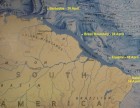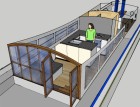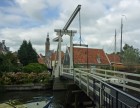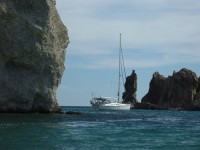Sequitur
Michael & Edi have headed out on a slow, thorough exploration of the globe.
| Vessel Name: | Sequitur and Zonder Zorg |
| Vessel Make/Model: | 2007 Hunter 49 and 1908 Wildschut Skûtsje |
| Hailing Port: | Vancouver, Canada |
| Crew: | Michael Walsh & Edi Gelin |
| About: | For our current location click, on Map & Tracking, then on the Google Earth logo. |
| Extra: | Follow us on Twitter: Follow @YachtSequitur |
| Social: |
13 January 2014
Another New Book Released
I am delighted to announce that my new book: Carefree on the European Canals is now in print and is available on Amazon.com, Amazon.ca [...]
26 April 2013
New Book Released
The proof copy of my new book arrived by courier today. I have approved it and it is now listed on Amazon for pre-order, with a publication date of 30 April. It is a rather large book at 680 pages in an 8.5 by 11 inch format with 315,000 words illustrated by over 2400 colour photos, charts and maps. [...]
24 April 2013
One Year Out of Brazil
One year ago today we sailed Sequitur out of Brazil after enduring more than six weeks in the least-friendly country that we had experienced during our three-year voyage. In the early evening of 24 April 2012 we crossed the line on the chart dividing Brazil from French Guyana and breathed a huge sigh [...]
27 October 2012 | Harlingen, Friesland
Planing a Metamorphosis
We have added a new post to the Zonder Zorg blog at: Planing a Metamorphosis.
29 September 2012 | Sneek, Netherlands
Onward to Friesland
We have arrived in Friesland and have added a new post to the skûtsje's blog at: Onward to Friesland
19 September 2012 | Hoorn, Netherlands
North From Aalsmeer
We have moved northward from Aalsmeer and I have added two new posts: Heading North From Aalsmeer and North From Amsterdam
13 September 2012 | Aalsmeer, Netherlands
Taking Possession
We are back in the Netherlands, and I have added some new posts to the ZonderZorg blog at: Taking Possession and Settling-In and Making Plans
20 August 2012 | Sequitur: St Augustine, USA - Michael & Edi: Vancouver, Canada - Nieuwe Zorg: Aalsmeer, Netherlands
Added a New Website
We have added a new website: Skûtsje ZonderZorg. Zonder zorg in Dutch means without worry. Our intention with the site is to provide a place to share some of the history, geography and culture of the skûtsje as we discover it. We will also use this place to document [...]
11 August 2012 | Sequitur: St Augustine, USA - Michael & Edi: Vancouver, Canada - Nieuwe Zorg: Aalsmeer, Netherlands
Still More Skûtsje History
We continued to attempt to track-down Douwe Albert Visser, who was the owner of Nieuwe Zorg in 1941 when she was re-registered. One of the problems we repeatedly encountered in our online searches was the effect of currently having Albert Visser and two Douwe Vissers as very competitive skûtsje racers, [...]
10 August 2012 | Sequitur: St Augustine, USA - Michael & Edi: Vancouver, Canada - Nieuwe Zorg: Aalsmeer, Netherlands
Some More Skûtsje History
While I was researching the history of Nieuwe Zorg, I finally found her first registration details obscured by an apparent typographical error in a transcribed online spreadsheet. She was listed as having been built in 1901 instead of 1908. I emailed the webmaster of the [...]
Passage to Acapulco
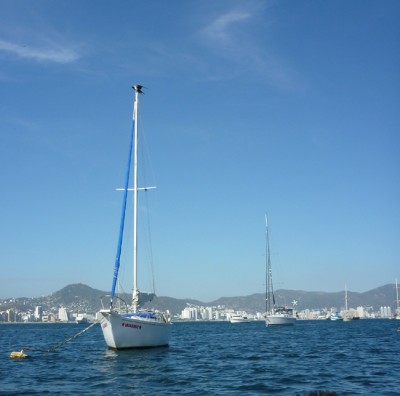

The haze turned-out to be the huge pall of smoke coming from the stacks of the oil-fired electrical generating plants that power Manzanillo and the surrounding area. Its pollution coverage appears likely to be as broad as its electrical coverage. I now know why our watermaker pre-filters clogged so quickly.
We also discovered why we were unable to see the twin volcanoes, 4330 metre Nevado de Colima and 3860 metre Volcan de Colima less than 90 kilometres inland. Besides fouling its own nest the emissions from the power plant drift inland and hang as smog over the city of Colima in the once pristine valley at the base of the volcanos. The smog hides the volcanoes from view, not only from Colima, but from the coast and to seaward.

When I had shortened-in the anchor chain, the first three metres or so below the waterline were coated in a thick fur of mud, as were the nylon snubbers where they had been in the water. The remainder of the rode and the anchor came up relatively clean, but the upper layer of water had really dirtied the chain and the snubbers. Sequitur's decks were also dirty, with a dark brown, oily dust.
We were running low on diesel, having not refuelled since January, and having had to run the main engine to top-up the batteries, rather than the much less hungry generator. Although there was a fuel dock in the marina at Las Hadas, we had decided not to refuel there. The fuelling facility was being used as moorage by ten or a dozen power boats, lying back from buoys and anchors and Mediterranean-moored to the dock, blocking all access to the pumps. We didn't relish the hassle of having them leave to make room for our fuelling. Besides, with the preponderance of boats using the marina being gasoline-guzzling small powerboats, with very few diesels, we wondered about the condition of the diesel oil we would get there.
We needed to sail as much as possible and conserve fuel. The air started moving a bit as we rounded Roca Vela and bent out course to the southeast, so at 0859 I hauled out the main and the jib, shut down the engine and we wafted along on a port tack at 3.5 to 4 knots in a 6 to 8 knot easterly breeze. An hour or so later as we watched the Holland America cruise ship Maasdam pass 9 miles to our southwest, I called them on VHF. They immediately responded and confirmed that we showed clearly on their AIS and we painted well on their radar. There was no need to do a radio check; that was accomplished by their instant and clear response. Four things done with one easy call, besides the three electronic checks, we also had the satisfying feeling that we are very visible to passing ships.
The breeze slowly veered, and by noon it was southwest, just abaft the beam and still around 6 to 8 knots. We had tacked and were ghosting along at about 3 to 4 knots. We continued thus through the remainder of the day and into the darkness of the New Moon night. Around 0300 on Wednesday morning the winds became fickle and combined with a sloppy cross-sea, so I flashed-up, furled the sails and we motored until sunrise, when I again hauled-out the three sails. The breeze had continued to veer and in the early daylight it crossed our stern to the port quarter. We jibed and moved along at about 3 knots.

Mid-morning I went to the foredeck to haul the asymmetrical spinnaker up from the sail locker, unpack it and sort it out. This was the first time we have had conditions in which to fly the spinnaker this trip. Well, actually, since I had never before flown a spinnaker, not just this spinnaker, but any spinnaker, I had probably allowed a tad of inertia to assist with my judgement of when it might be of use.

I did a slow and deliberate lay-out and analysis, and tried to remember details from the how-to video I had viewed two years previously when the spinnaker arrived from North Sails. I guess a combination of memory and logic came through, because we easily managed to rig, hoist and deploy the spinnaker on the first attempt. I had furled the jib before un-socking the spinnaker, and after deployment, rolled in the main. We moved along at 2.5 to 3 knots in the 5 to 6 knot breeze over our port quarter.
Our next port along the coast was Zihuatanejo, a 200 nautical mile run from Las Hadas, a 30 to 36-hour passage in the forecast 10 to 15 knot winds. But to this point we had seen winds at half the forecast strengths, and our thoughts of an arrival in the afternoon of the second day had long since passed.
The wind continued backing and by late afternoon on Wednesday it was from the west at 5 to 6 knots and we lazed eastward at around 3 knots under spinnaker alone, with the Hydrovane keeping us on the best downwind course. At 2005 the sun set to find us with a four-hour run of 085 degrees, 12.7 miles, just shy of 3.2 knots.

By sunrise, the spinnaker spent more time hanging like wet laundry than it did filled and pulling. We were still moving along at a bit over a knot in the 2 to 3 knot puffs. By 1000, with still 32 miles to Zihuatanejo, I socked the spinnaker, flashed-up the engine and we motored at 1750 rpm, making 6 knots.

As we motored, we started passing sea turtles, easily made visible by the sun glinting off their backs a hundred metres and more ahead in the rather calm seas. Most passed at fifty and more metres from Sequitur, but a few were within twenty metres. A metre-long one passed almost within touching distance down the port side.

We saw a couple dozen of them in half an hour, all heading west, and we wondered how large this group was, whether it was a group or just a collection of individuals, where the turtles were going, whether they were going anywhere or just going west for a while. Three of the turtles we watched had birds riding on their shells. We thought this might be a symbiotic relationship, with the turtle being groomed of parasitic creatures and the bird feeding.
At 1533 we came to 23 metres on the Rocna in 7.8 metres of water in Bahia de Zihuatanejo, having covered 230 miles to make the 200 mile passage, and having sailed all but 10 hours of the 55 hour trip in winds of 8 knots and less. We had decided to stop here to refuel, thinking it might be prudent before continuing on to Acapulco. We spent the remainder of the day relaxing onboard.
On Friday morning we launched Non Sequitur and headed over to the Pemex fuelling pier to arrange for our fuelling. There were many small boats secured to the concrete pier, and the closer we approached the more obvious it became that the fuel dock had been abandoned. The pumps were still in place, but they were stripped of their hoses and were looking forlorn. We went then to the pier leading to the Port Captain's office, only to find the office closed.

I spoke with a couple of young local men, who said they could refuel by ferrying tanks to us in their water-taxi. I asked where they would buy the fuel, and was told up the inlet beside the pier. We took the dinghy under footbridge and up the small inlet. It was a fetid, brown-water drainage rimmed with fishing pangas and small runabouts and leading into what appeared as squatters habitations at the edge of really desperate slums. Actually, from the flotsam on the surface of the lagoon, and from its aroma, brown-water was a bit too kind a description. If the diesel fuel came from here, we wanted nothing to do with it. We decided to continue south first thing the next morning.
At 0747 on Saturday, just as the sun was rising, we weighed and proceeded out of Bahia de Zihuatanejo under clear skies and still airs through the glassy-calm seas. Half an hour later, as we rounded Roca Negra we found a 5 to 6 knot easterly, likely the remains of the overnight land breeze. We un-socked the spinnaker and lolled along at 2.5 to 3 knots with Hydra steering us southward. We needed to make some southings to reach Acapulco, and decided we may as well take them now as they were offered.
The breeze veered and abated, and by 1015 the spinnaker was spending more time hanging limp than it was filled. We motored to the southeast until 1245, when there was sufficient sea breeze to have the spinnaker pull us along on a starboard tack at 2.5 knots. Through the remainder of the afternoon the breeze pushed us 18 miles southeast and in the early evening it veered to the northwest and increased to 8 to 10 knots. We continued at about half the wind speed.
At midnight we were making a good 5.5 knots to the south east in northwest winds of 10 to 12 knots. The wind veered slowly and by 0500 it had taken us to Acapulco's latitude. We jibed to steer east on a port tack and continued toward our destination at 5.5 to 6.5 knots in the northwest winds of 11 to 13 knots. At sunrise the winds had veered to a bit east of north, so we dowsed the spinnaker and rolled out the jib and main to continue eastward on a close reach. By mid-morning the winds had eased and come more onto our nose, so we flashed-up, rolled-in and motored into Acapulco Bay.
The anchorage was full of mooring balls, most of them occupied, and the areas without mooring balls were in depths of 25 and more metres. There were some small spaces among the mooring balls, but they were also in water 20 to 25 metres deep, and there was insufficient swinging room for even a short scope. We slowly motored through the anchorage, up one row and down the next, then over to a likely spot only to find a small previously unseen float. We were heading back to the outer and deeper edge of the anchorage to drop our Rocna, when we were approached by a man in a small skiff, who introduced himself as Hugo.
At 1210, after some quick negotiations he passed our line through the eye of his mooring ball, we secured to it and then passed him 700 Pesos for a two-day stay. We were just off the centre of the anchorage, and a close dinghy run to the piers and facilities of Club de Yates de Acapulco. We spent the remainder of Sunday onboard relaxing and cleaning. While I scrubbed above decks, Edi cleaned and organized below.



